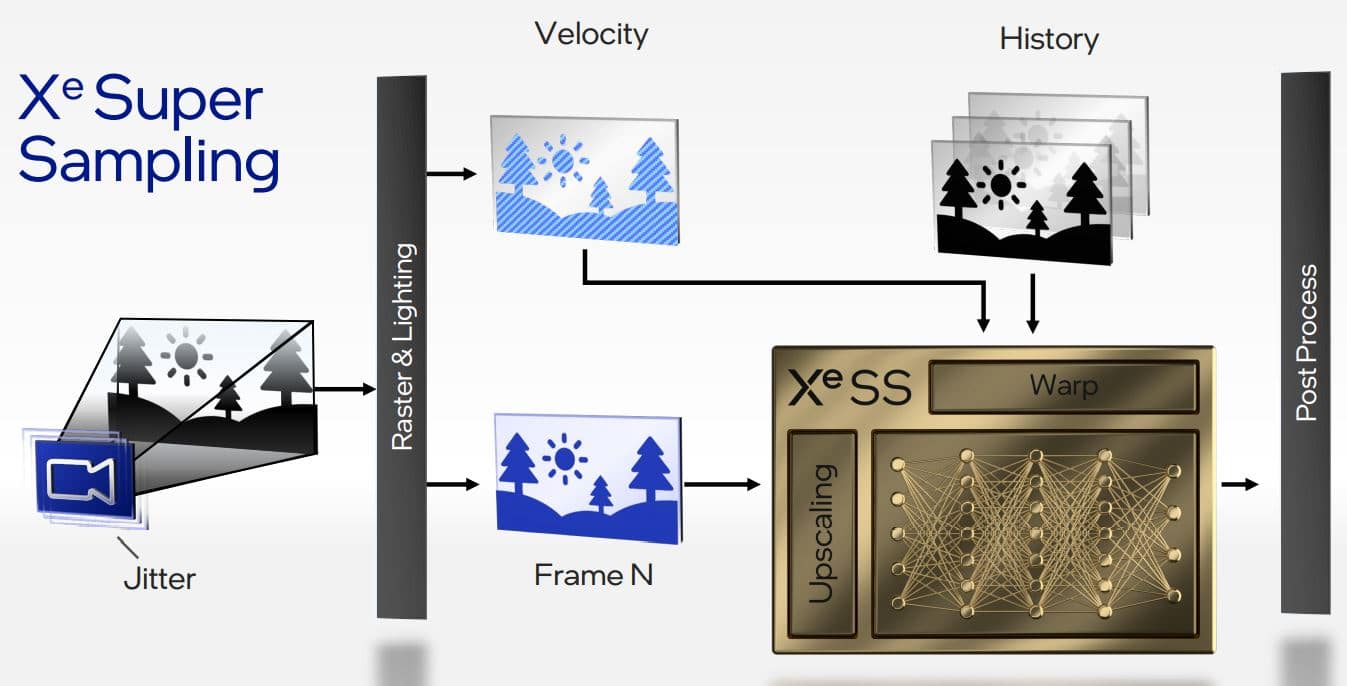Intel XeSS, new details on the technology that challenges DLSS and FSR
Last week, on the occasion of the Architecture Day 2021, Intel entered a little more into the details of its return to the dedicated GPU sector, focusing in particular on the technical part relating to the Xe HPG GPU intended for the gaming sector and anticipating the arrival of technology XeSS, Xe Super Sampling, as the “antagonist” solution of NVIDIA DLSS and AMD FSR.
During an interview with the Wccftech site, Intel’s Principal Engineer for XeSS, Karthik Vaidyanathan, has released other interesting details about XeSS that help us understand a little better how the technology works and what are the expectations and intentions of the US company.
First of all, Vaidyanathan explained that Intel XeSS, like NVIDIA DLSS 2.0, does not require “training” for every single game, but it will be a technology based on an easily integrated API that uses deep learning to synthesize images with a quality very similar to the native one. As proof of this, if you will, the fact that the demo shown during the Architecture Day was based on virgin material, that is, not used to train XeSS.
“[] You have seen the demo and I can say that XeSS has never seen it. She was never trained on that demo. All the content from that scene you saw was not used as part of our training process, “Vaidyanathan explained to Wccftech’s Usman Pirzada.
While XeSS looks more like DLSS than FSR in operation, Intel’s technology it will also support GPUs from other manufacturers and, even if at the moment it cannot be said with the utmost certainty, the graphics chips concerned could be those Pascal, Turing, Ampere from Nvidia and RDNA 1 and 2 from AMD.
Intel has indeed worked on two variants of the technology, one accelerated by the XMX (Xe Matrix Engine) units present in the Xe-Core and exclusive to Alchemist (first generation Intel Arc) GPUs, and one based on DP4a instruction supported by Microsoft Shader Model 6.4 compatible GPUs. And thanks to DP4a, albeit with some slight compromises (a slightly longer rendering time, but still lower than the native 4K), that XeSS will run on competitive GPUs and not necessarily only on the latest models.
By the way, developers shouldn’t have any problems implementing XeSS support, as the two variants will be “covered” by a single API. “I would like to point out that both the DP4a and XMX versions are exposed via the same API. So, as far as integration is concerned, the same. What the game engine sees is the same interface and, under that interface, you can select the DP4a or XMX version and depending on the platform. So I wanted to clarify that they are not two different interfaces. the same interface and the same library that integrated with two different paths in it, which makes it much easier for game developers ” Vaidyanathan explained.
The engineer also clarified that the XMX version of XeSS will not take advantage of the Tensor Cores of the Nvidia Turing and Ampere GPUs. “Ah, no. Until there is a standardization on cross-platform matrix acceleration, it’s not easy for us to make something that works on all types of hardware. DP4a has reached a stage where it supports it on all platforms, certainly. all modern ones. So this makes it easy for us. Matrix acceleration not in the same phase, so our dedicated Intel XMX implementation. ”
At the moment the US company it does not even provide a fallback option using FP16 / 32 formats. “No, not at the moment. We will look into it, but I can’t commit to positive or negative right now. Also, even if it were possible to do so, there is the big question about performance and whether it is justified.”
Vaidyanathan ha spiegato che XeSS avr, like FSR and DLSS, more qualitative modes to give players full control on technology in terms of detail and performance depending on the GPU in your possession. Intel also is already thinking about the future 2.0 and 3.0 evolutions of XeSS, as well as making technology open source as soon as it is considered sufficiently mature.
















